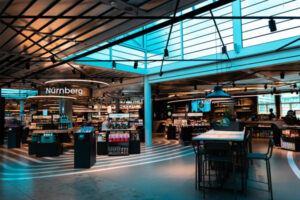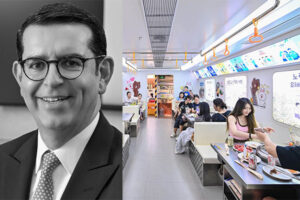Corona has changed many things. And Corona will have long lasting effects on our society, economy and politics. Covid-19 is without doubt the greatest challenge since the Second World War, also for the real estate industry and across all asset classes. Retail real estate is particularly in focus.
At the beginning of 2020, Kaufland analysed the underlying conditions such as mobility, competition, consumer behaviour, demographics as well as sustainability and digitalisation in the study “Footfall-Anchors in the Online Age – 10 Reasons for a Stable Future”. The pandemic has confirmed this to be correct. These trends were given a new perspective partly due to the rapid acceleration and the term social distancing. This is reason enough for the subsequent study, “Footfall-Anchors Post Corona – 5 Propositions for the New Future of Retail”, to discuss the current situation in retail and retail real estate for the property sector, developers and municipalities. What does a footfall-anchor look like post Corona? First a short update on the ten reasons for stability:
Freshness and convenience: the food retail industry made it clear in the pandemic how systemically important it is. The considerable importance of groceries, in particular fresh products has been highlighted.
Variety and price: one-stop shopping in times of social distancing has increased even further. A large grocery selection creates real added value.
Shopping experience and foodservice operators: creating a positive shopping atmosphere, especially under Corona regulations is not easy, however essential. In addition, foodservice providers are an important element for a vibrant shopping location and Corona has not changed this situation.
Digitalisation and the new consumer: there is no doubt Corona has given digitalisation new impetus. In the grocery sector, the bricks and mortar format remains stable and is merely being complemented and not replaced by digitalisation.
Urbanism and mixed-use: new urban concepts will also gain significance, more so due to the pandemic. Location-specific, mixed solutions are increasingly in demand.
Architecture and appearance: functioning retail architecture also serves to represent the location and this will remain important even after Corona.
Compatibility and footfall-anchors: municipal development guidelines for retail as well as regional and state retail planning regulations require fundamental rethinking. More flexible and cooperative town planning solutions are necessary for redeveloping our cities.
Sustainability and responsibility: Environment-Social-Governance (ESG) is more relevant than ever. It is one of the long-term trends and requirements.
Synergy and potential fit: a good tenant mix provides many advantages for retailers, municipalities and in particular for customers. Working in partnership with existing leases is especially important in managing the crisis. This should continue to be the case in the future.
Core assets and reliability: Corona has adjusted retail asset class allocations yet again. Neighbourhood retail with reliable tenant partners is now a core investment product more so than ever.
Freshness and convenience: The food retail industry made it clear in the pandemic how systemically important it is. The considerable importance of groceries, in particular fresh products, has been highlighted.
Variety and price: One-stop shopping in times of social distancing has increased even further. A large grocery selection creates real added value.
Shopping experience and foodservice operators: Creating a positive shopping atmosphere, especially under Corona regulations is not easy, however essential. In addition, foodservice providers are an important element for a vibrant shopping location and Corona has not changed this situation.
Digitalisation and the new consumer: There is no doubt, Corona has given digitalisation new impetus. In the grocery sector, the bricks and mortar format remains stable and is merely being complemented and not replaced by digitalisation.
Urbanism and mixed-use: New urban concepts will also gain significance, more so due to the pandemic. Location-specific, mixed solutions are increasingly in demand.
Architecture and appearance: Functioning retail architecture also serves to represent the location and this will remain important even after Corona.
Compatibility and footfall-anchors: Municipal development guidelines for retail as well as regional and state retail planning regulations require fundamental rethinking. More flexible and cooperative town planning solutions are necessary for redeveloping our cities.
Sustainability and responsibility: Environment-Social-Governance (ESG) is more relevant than ever. It is one of the long-term trends and requirements.
Synergy and potential fit: A good tenant mix provides many advantages for retailers, municipalities and in particular for customers. Working in partnership with existing leases is especially important in managing the crisis. This should continue to be the case in the future.
Core assets and reliability: Corona has adjusted retail asset class allocations yet again. Neighbourhood retail with reliable tenant partners is now a core investment product more so than ever.
HIGH FIVE is the explorative format of the Kaufland real estate department:
1 topic – 1 expert – 5 questions
Leading experts from the real estate sector examined the future of retail real estate in a post Corona age. The following dimensions were thereby analysed and evaluated:
The new post Corona world for the real estate sector
(Dr. Hans Volckens, KPMG)
Investment markets post Corona
(Henrike Waldburg, Union Investment)
Financing post Corona
(Gero Bergmann, Berlin Hyp)
Fund strategies post Corona
(Daniel Herrmann, Patrizia)
The future of grocery retail
(Kathrin Andres, Nuveen)
The future of shopping centres
(Alexander Otto, ECE)
The future of the high street
(Lars Heese, Redevco)
The future of specialist retailers
(Florian Lauerbach, ILG)
The view from outside: Germany as an investment market
(Johnnie Wilkinson, Greenman)
Sustainability topics post Corona
(Dr. Christine Lemaitre, DGNB)
Corona has shown that long-term trends in retail have not disappeared and that some have even accelerated. We have identified 5 topics that stand out from the assessment by retail real estate experts. As a result the following picture has emerged:

The pandemic and its impact will preoccupy our society, the economy and politics for a long time to come. The transformation in retail and thus on retail real estate will advance further. It is one of the most exciting futures. Let’s tackle it! The supermarket sector will play a crucial role in dealing with these new challenges. Kaufland is ready to take on these challenges together with its large-scale supermarket concepts: for strong retail locations, attractive municipalities and reliable investment: #footfallanchor







